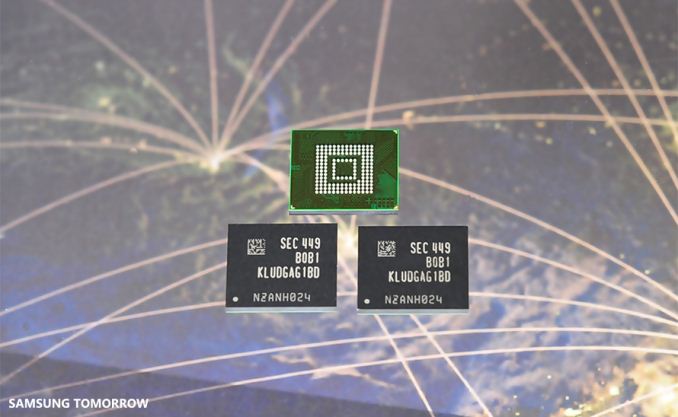Samsung Announces 128GB UFS Storage For Smartphones
by Andrei Frumusanu on February 25, 2015 7:55 PM ESTWe've first heard about plans to adopt UFS (Universal Flash Storage) with the announcements of Toshiba and Qualcomm reported over a year ago. While the promised late 2014 schedule seems to have been missed, and we still haven't seen any major product with the technology, it looks like UFS is finally gaining some traction as today Samsung is announcing the mass production of in-house solutions based on the UFS 2.0 standard.
Samsung claims to provide the new embedded memory type in 32GB, 64GB and 128GB capacities. The 128GB model doubles the amount of storage even their biggest eMMC storage solution is able to deliver. It was only last week that Samsung recently released a new eMMC 5.1 based NAND line-up which promised major gains over today's deployed eMMC products.
The UFS solution claims to achieve 19K IOPS (Input/output operations per second) in reads, almost double that of the 11K IOPS their eMMC 5.1 solution is capable of, and 2.7X times what common embedded memory is capable of today. There is also a purported boost to sequential read and write performance to SSD levels, although Samsung doesn't provide any actual figure, so we'll have to wait until we review a device to see what the actual gains are. What should be very interesting is a promised 50% decrease in energy consumption. We're still not very sure on the impact of eMMC power on a smartphone's battery life, but scenarios such as video recording are certain use-cases where a decrease in NAND power could be very beneficial to battery life.
UFS is based on a serial interface as opposed to eMMC's parallel architecture, enabling Full-Duplex data transfer and achieving twice to four times the peak bandwidth (depending on implementation) over the existing eMMC 8-bit interface.

Samsung offers the solution also in an ePoP package, meaning the NAND IC is embedded with the RAM ICs in a PoP package on top of the SoC, a solution already employed in the Galaxy Alpha and Galaxy Note 4. The goal here is to save on precious PCB space in small form factors such as smartphones.
We're looking forward to see in what kind of devices Samsung implements the technology and how it affects their performance and responsiveness.
Source: Samsung Tomorrow











31 Comments
View All Comments
WorldWithoutMadness - Wednesday, February 25, 2015 - link
Please don't take Samsung flagship if you want to give android a try.I don't recommend their awful bloated UI which gives android a bad name. Unless you're planning to install custom ROM which is quite adventurous for someone who want to give something a try.
Let's just be fair, go to find nexus 5/6 (reference model) and galaxy S5, compare them and find which one you like. I do prefer 6 as it is made to be premium not cutting off here and there like nexus 4/5.
Microsoft should release win10 on June/July if they want to catch up with back-to-school so you might get it earlier. Hey, it's not Ballmer era anymore.
CSMR - Thursday, February 26, 2015 - link
New phones around October make sense for Microsoft and customers because 1. the new generation of 20nm Snapdragon processors will be out (a process advance only happens every 2 years) and 2. Windows Phone 10 will be out.To get media attention you need to release new models constantly but in reality the hardware only moves forward significantly once every two years and the software updates old models as well as new models.
CaedenV - Wednesday, February 25, 2015 - link
This is great news! Phones have very capable CPU, GPU and wireless transfer speeds. Phones made in the last year or so even have decent RAM speeds. But there is not a phone on earth yet with acceptable eMMC storage speed. It just makes phones feel so slow and sluggish when they are capable of so much more!I mean, my desktop, which is loaded down with software, can boot in ~4-7 seconds, so why do phones take 30+ seconds to boot when there is nothing there to begin with? This should really help speed things along.
Pissedoffyouth - Thursday, February 26, 2015 - link
My emmc windows tablet boots in that kind of time. Its an android thing I thinkmkozakewich - Thursday, February 26, 2015 - link
My phone takes over a minute to boot, while my Windows tablet boots in maybe 20 seconds.GlynG - Thursday, February 26, 2015 - link
Will phones come with just one of these chips or might this finally lead to 256GB phones? I'd be very keen for 256 + 128GB micro-sd storage.Klug4Pres - Thursday, February 26, 2015 - link
Saygus V², if released, will have 64GB plus 2 microSDXC slots for 320GB potential total capacity.By the way, it's UFS-II not UFS 2.0 as Samsung says in their press release and as has been repeated in this article.
extide - Thursday, February 26, 2015 - link
No, the article is correct. You are thinking of UHS-I and UHS-II, not UFS.Klug4Pres - Friday, February 27, 2015 - link
You are right. UFS, promoted by JEDEC, is actually a rival specification to traditional SD cards, promoted by the SD Association. The latest SD bus interface is UHS-II.However, it would appear the initial focus of UFS is likely to be in embedded applications, potentially rivalling the eMMC standard, rather than in external card storage.
Got confused there.
extide - Sunday, March 1, 2015 - link
Yeah, I would assume, hope, and expect that UFS stays in the embedded world, essentially replacing eMMC. While it was nice (for embedded developers) to be able to use the same interface for SD cards and eMMC, an improvement is always great. Although when it come to removable SD cards, having another (in-compatible) standard isn't going to be a great thing.